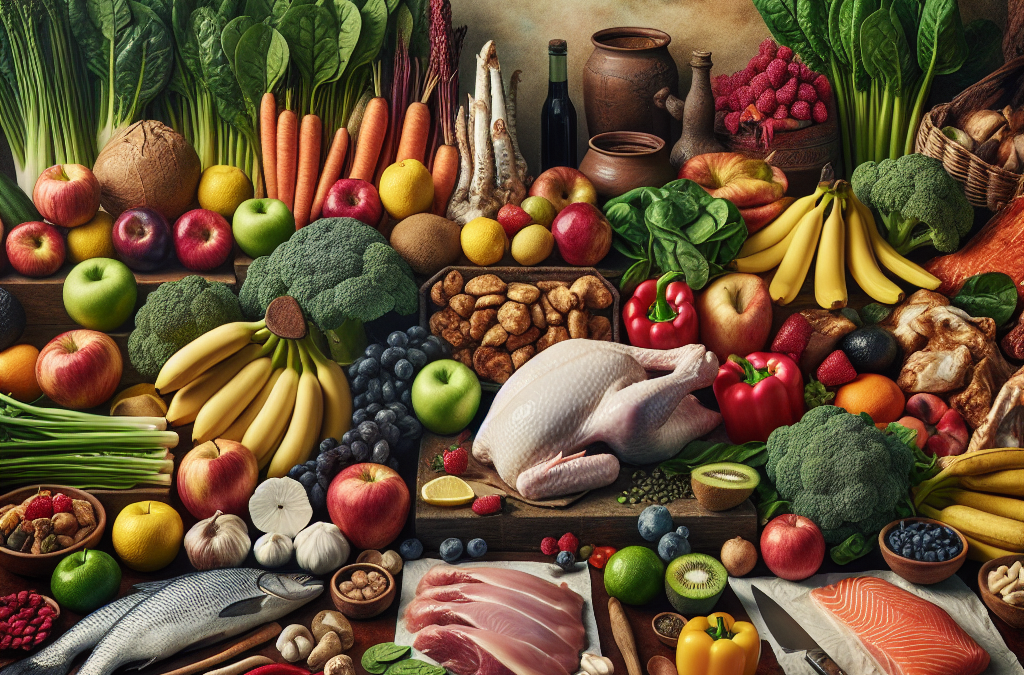In 2025, focusing on whole food fiber sources is more important than ever for maintaining optimal health. As fiber plays a crucial role in digestive health, weight management, and heart wellness, choosing natural, whole foods packed with fiber is a smart strategy. Incorporating a variety of these whole food fiber sources into your daily diet can lead to noticeable health benefits.
Many people overlook the power of whole foods when it comes to fiber intake, relying instead on supplements or processed options. However, prebiotic fibers present in fruits, vegetables, grains, and nuts provide not only fiber but also essential nutrients. Exploring these options ensures you get the maximum health benefits while enjoying delicious, natural foods.
Understanding Whole Food Fiber Sources
What Are Whole Food Fiber Sources?
Whole food fiber sources are natural, minimally processed foods rich in dietary fiber. They include fruits, vegetables, whole grains, nuts, and seeds, providing both soluble and insoluble fibers. These foods support healthy digestion and help regulate blood sugar levels naturally.
Unlike fiber supplements, whole food fiber sources offer a complex mix of nutrients, antioxidants, and phytochemicals that work together to promote overall health. Emphasizing these sources in your diet ensures you get fiber in its most natural and beneficial form.
The Benefits of Whole Food Fiber Sources
Consuming whole food fiber sources can improve gut health by promoting beneficial bacteria growth and regular bowel movements. Additionally, they can aid in weight management by increasing satiety and reducing overeating tendencies.
These natural foods also support cardiovascular health by helping to lower bad cholesterol levels. Incorporating diverse whole food fiber sources into your diet is a holistic approach to boosting your overall well-being.
Difference Between Soluble and Insoluble Fiber
Soluble fiber dissolves in water, forming a gel-like substance that helps lower blood cholesterol and stabilize blood sugar levels. Common sources include oats, apples, and legumes. Insoluble fiber adds bulk to stool, aiding in regular bowel movements, and is found in whole grains and nuts.
A balanced intake of both types of fiber from whole food sources is essential for optimal health. This combined approach ensures your digestive system functions smoothly while providing other metabolic benefits.
Recommended Daily Intake of Fiber in 2025
The general recommendation for adults is about 25 to 30 grams of fiber per day, primarily from whole food sources. Meeting this target can significantly improve digestion and reduce the risk of chronic diseases.
Achieving sufficient fiber intake involves incorporating a variety of whole food fiber sources like fruits, vegetables, whole grains, nuts, and seeds into your meals. Planning balanced, fiber-rich meals ensures you enjoy all the health benefits this dietary approach offers.
Top Whole Food Fiber Sources in 2025
Whole Grains and Cereals
Whole grains such as oats, brown rice, quinoa, and barley are essential whole food fiber sources. These grains retain their bran and germ, providing high levels of dietary fiber along with vital nutrients like B vitamins and minerals.
For a fiber boost, opt for whole grain cereals and breads rather than refined options. These foods support sustained energy levels and promote healthy digestion as we move into 2025.
Fruits Rich in Dietary Fiber
Berries, apples, pears, oranges, and kiwis are standout whole food fiber sources that you can enjoy daily. These fruits contain both soluble and insoluble fibers, making them versatile for many dishes and snacks.
Incorporating a variety of fruits into your diet not only boosts fiber intake but also provides antioxidants and vitamins that enhance your overall health. Fresh, whole fruits are always the best choice for maximum benefits.
Vegetables for Optimal Fiber Intake
Vegetables like carrots, broccoli, Brussels sprouts, and sweet potatoes are excellent whole food fiber sources. Their high fiber content aids digestion and helps maintain a healthy weight.
Including a colorful array of vegetables daily ensures you receive diverse fibers and phytochemicals, essential for preventing chronic illnesses and supporting your immune system.
Nuts, Seeds, and Legumes
Almonds, chia seeds, flaxseeds, lentils, chickpeas, and black beans are powerhouses of fiber among whole food sources. They also provide healthy fats, proteins, and micronutrients.
Adding these foods to salads, smoothies, or snacks is an easy way to boost fiber intake naturally. They support heart health and help Satisfy hunger in a nutritious way.
Incorporating Whole Food Fiber Sources into Your Diet
Meal Planning and Preparation
Planning balanced meals around whole food fiber sources is key to hitting your daily targets. Incorporate oats or whole grain bread for breakfast, add beans or lentils to lunches and dinners, and include a variety of fruits and vegetables throughout the day.
Huge Discount on the Best Certified Organic Whole Food Supplement!
Preparing foods in advance helps ensure you always have access to fiber-rich options, making it easier to stick to healthy habits. Experimenting with new recipes can keep your diet interesting and satisfying.
How to Maximize Fiber Intake
To maximize your intake, aim to include at least three to five different whole food fiber sources each day. Combining fruits, vegetables, grains, and nuts provides a diverse fiber profile that benefits your gut bacteria and overall health.
Be mindful of gradual increases to prevent digestive discomfort and drink plenty of water to help fiber do its job effectively. Small, consistent changes can make a substantial difference over time.
Practical Tips for Daily Consumption
Incorporate chopped nuts or seeds into oatmeal, salads, or yogurt for easy fiber boosts. Keep ready-to-eat fruits and vegetables available for quick snacking throughout the day.
Experiment with new whole grains like millet or amaranth for variety and added nutrients. Using herbs and spices can enhance flavor without adding sugar or salt, making healthier choices more enjoyable.
Overcoming Common Challenges
Some may find increasing fiber intake challenging due to digestive sensitivity or habits. Starting slowly and increasing intake gradually helps your system adjust comfortably.
Additionally, ensuring adequate hydration is essential when boosting fiber consumption, as water helps fiber pass smoothly through the digestive tract. Consulting with a healthcare professional can provide personalized guidance tailored to your needs.
Frequently Asked Questions about Whole Food Fiber Sources
What are the best whole food fiber sources to include in a balanced diet in 2025?
The best whole food fiber sources include a variety of fruits, vegetables, whole grains, nuts, seeds, and legumes. Incorporating a colorful mix of these foods ensures you benefit from both soluble and insoluble fibers. Aim to include several servings of these each day for optimal health benefits.
For instance, start your day with oatmeal topped with berries and nuts, add lentils or chickpeas to your salads, and snack on fresh fruits and vegetables. Variety not only improves taste but also maximizes your fiber and nutrient intake.
How much fiber should I aim for daily from whole food sources?
The recommended daily intake for adults is about 25 to 30 grams of fiber from whole food sources. Achieving this can significantly improve digestive health and reduce risks of chronic diseases like heart disease and diabetes.
To reach your goal, focus on integrating fiber-rich foods into all meals—think whole grains at breakfast, vegetables at lunch and dinner, and nuts or seeds as snacks. Gradually increasing your intake helps your digestive system adapt comfortably.
Can I get enough fiber from processed foods or should I focus on whole food sources?
While some processed foods are fortified with fiber, they often lack the full spectrum of nutrients found in whole food fiber sources. Relying on whole foods ensures you’re receiving a complex array of fibers along with vitamins, minerals, and phytochemicals.
For optimal health, prioritize fresh or minimally processed whole food sources like fruits, vegetables, and grains. These natural options are more effective and satisfying for meeting your daily fiber needs.
What are some practical ways to incorporate more whole food fiber sources into my daily meals?
Start by adding sliced fruits or vegetables to your breakfast or snacks, swapping refined grains for whole grains, and including a handful of nuts or seeds in salads and yogurts. Meal prepping with fiber-rich ingredients can also save time and make healthy choices more accessible.
Simple substitutions, like choosing brown rice instead of white, or adding beans to soups and stews, can significantly boost your fiber intake. Over time, these habits become natural parts of your lifestyle.
Conclusion
Emphasizing whole food fiber sources is a powerful approach to enhancing your health in 2025 and beyond. Natural foods like fruits, vegetables, whole grains, nuts, and seeds provide essential fibers that support digestion, heart health, and weight management. Making these foods a central part of your diet ensures you reap the maximum benefits of their complex nutrients and dietary fibers, paving the way for a healthier, more vibrant life.
Huge Discount on the Best Certified Organic Whole Food Supplement!
Find out more information about “whole food fiber sources”
Search for more resources and information:




